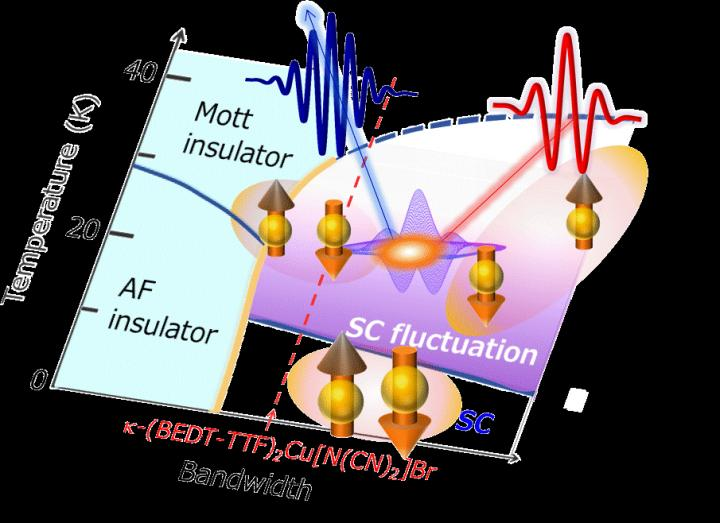Sep 7 2020
In contemporary information technology (IT), the movement of electrons in a central processing unit (CPU) is responsible for processing and carrying the data.
 Schematic illustration of the SHG induced by a petahertz non-linear current in an organic superconductor κ-BEDT-TTF compound. Image Credit: National Institutes of Natural Sciences/Institute for Molecular Science.
Schematic illustration of the SHG induced by a petahertz non-linear current in an organic superconductor κ-BEDT-TTF compound. Image Credit: National Institutes of Natural Sciences/Institute for Molecular Science.
The electrons within the electric circuits move in a preferred direction through an applied electric field. For instance, a “CPU clock,” which denotes the frequency of the on-off switching operation of the movement of electrons, is in an order of gigahertz (or 109 Hz).
By contrast, an oscillating field of light with a frequency of petahertz (or 1015 Hz) has the ability to achieve petahertz operation of the on-off switching of the electron motion. If electrons are moved with the light frequency, the rate of data processing can be one million times faster when compared to those in traditional computers.
But an electromagnetic oscillation of light has never induced a polarized current (that is, the time average of the current at the time of the light pulse is zero). This is because the field of the oscillating light field is either spatially or temporally symmetric.
A research team, from Tohoku University, Nagoya University, Institute for Molecular Science, Okayama Science University, and Chuo University, recently irradiated ultra-short laser pulses and succeeded in shifting the electrons in an organic superconductor in a particular direction.
According to Ohm’s law, an induced current (as well as the velocity of electrons) is in proportion to the electric field applied. It must be noted that according to Ohm’s law, the electrons are scattered several times in solids. As a matter of fact, electron-electron and/or electron-phonon scattering processes determine the material resistivity.
But if the electric field can be applied on the time scale that is shorter than that of the scattering time, the electrons in solids lack sufficient time to be averaged. The electrons should instead be expedited so that it produces a polarized net current.
Hence, the team used ultra-short laser pulses in an effort to achieve this “scattering-free current.” These pulses are adequately shorter than the scattering time of electrons (= approximately 40 fm in organic superconductors).
But this experiment has a major barrier: it is not possible to achieve the electric detection of such a short-time current; hence, the team used optical detection. Moreover, it is well known that second harmonic generation (SHG) has been the preferred method for identifying electronic symmetry breaking, like a macroscopic dipole moment seen in ferroelectrics. The polarized current, which is another kind of electronic symmetry breaking, can also induce the SHG.
The team directed the ultra-short laser that has a pulse width of around 6 fs (6 × 10−15 seconds) towards an organic centrosymmetric superconductor, called κ-(BEDT-TTF)2Cu[N(CN)2]Br, and identified an SHG, as shown in the above image. But this is contrary to common sense because the SHG is produced only in those materials where spatial symmetry is not intact.
The identification of the SHG in the centrosymmetric superconductor implies that a polarized net current is produced at the time of light irradiation.
To validate this non-linear polarized current, the team analyzed the carrier-envelope phase (CEP: the relative phase that exists between the oscillation of light and its envelope) reliance of the SHG, because the sensitive nature of the CEP is typical behavior of the SHG induced by the current.
A periodic change of the intensity of the SHG as a function of the CEP proves that the SHG, thus observed, can actually be attributed to the scattering-free current.
The team further showed the association between the superconductivity and the scattering-free current. The current result demonstrates that the SHG is indeed identified at temperatures less than 50 K [(greater than the superconducting transition temperature (TSC = 11.5 K)].
The outcome also demonstrates that the SHG intensity quickly grows toward the transition temperature of less than 25 K (∼2 × TSC). This suggests that the scattering-free current is responsive to a “superconducting fluctuation.”
In a majority of the superconductors, microscopic seeds of superconductivity, or the superconducting fluctuation, have been detected at temperatures higher than the superconducting transition temperature, and the increased intensity of the second harmonic appears to be associated with the superconducting variations.
With further understanding of the scattering-free non-linear petahertz current, we may be able to make computers with an operation speed of petahertz which is million times faster than the present ones of gigahertz. This phenomenon can be used also as a tool to elucidate the microscopic mechanism of superconducting states, because it is sensitive to the superconducting fluctuation.
Study Researchers
Journal Reference:
Kawakami, Y., et al. (2020) Petahertz non-linear current in a centrosymmetric organic superconductor. Nature Communications. doi.org/10.1038/s41467-020-17776-3.